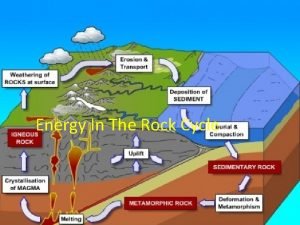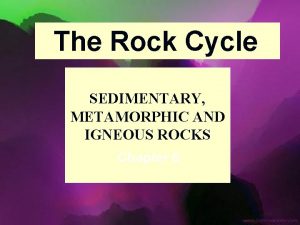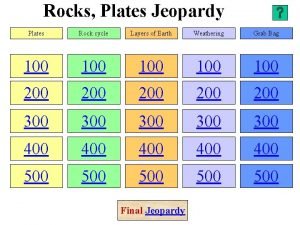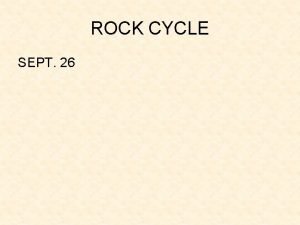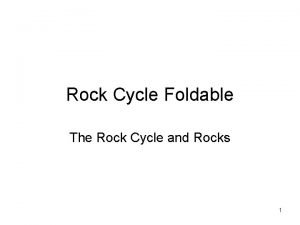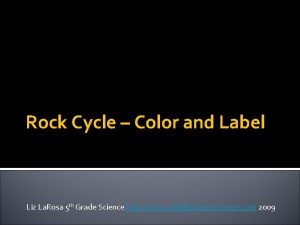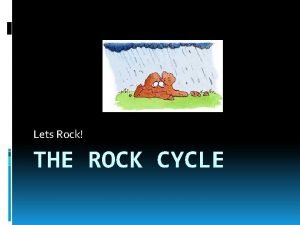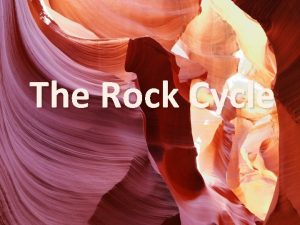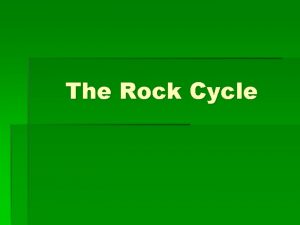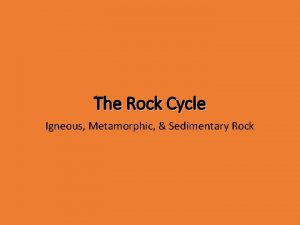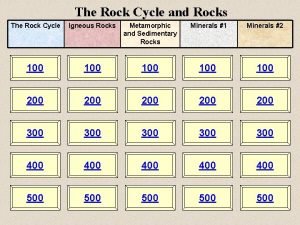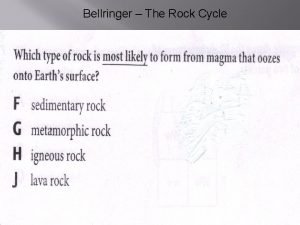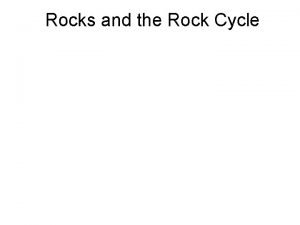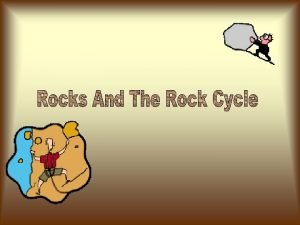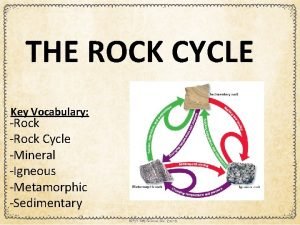Energy In The Rock Cycle Energy In The


















- Slides: 18

Energy In The Rock Cycle

Energy In The Rock Cycle • The rock cycle shows the possible ways in which one type of rock can slowly change to another type of rock. • The rock cycle is driven by different types of energy that slowly change rock. • The changes in the rock cycle usually take thousands to millions of years.

Solar Energy • Solar Energy drives the weather. • Weather erodes rocks. • Examples: – Wind breaks down rocks and moves sediments. – Rain slowly dissolves rock and moves sediments. – Ice Wedging - Snow melts and runs into cracks, freezes, expands, and breaks rock. – Glaciers scrape rock and carry sediment as they move. – Natural Disasters – Heat from the sun causes rock to crack or buckle from pressure caused by its atoms’ increasing speed.

Gravity • All objects have gravity. • Earth’s Gravity pulls all objects towards the center of the Earth. • Gravity helps move rocks and sediment from place to place. • Examples: waterfalls, rockslides, mudslides, glaciers

Chemical Energy • Chemicals dissolved in water harden sediments and cement them together to form new rocks as water evaporates or moves away. • Chemical reactions within the earth’s crust change rocks from one form to another.

Heat • Earth was once a molten ball of rock. • The earth’s interior still contains molten rock and metal. • Heat in the earth’s interior causes convection currents in the mantle that move the earth’s tectonic plates, causing earthquakes, mountain building, and volcanic activity. • Heat inside the earth causes rocks to melt partially or completely.

Radioactive Decay • Earth’s crust and mantle contain radioactive elements that heat rocks as they decay.

Pressure • As sediments pile up they put pressure on lower sediments and smash them together to make rocks. • When the earth’s tectonic plates move they push against each other. The resulting pressure changes the crystal structure and composition of rocks.

Picture Sources • • • http: //voyagerstories. wordpress. com/2009/02/11/the-rock-cycle/ http: //www. oum. ox. ac. uk/thezone/rocks/cycle/index. htm http: //www. icteachers. co. uk/children/sats/gravity. htm http: //www. softpedia. com/prog. Screenshots/Sun-3 D-Screensaver. Screenshot-19360. html http: //ees. nmt. edu/~dulmer/NMCEP%20 Nuclear%20 Energ y 2. html http: //web. ukonline. co. uk/silabob/fractal. html http: //open. salon. com/blog/greg_thomas/most_read http: //www. jamstec. go. jp/chikyu/eng/Chikyu. Images/science. html http: //comp. uark. edu/~sboss/study 3 s 02. htm http: //anand-vsiyer. blogspot. com/ http: //www. stockpix. com/stock/nature/geology/3204. htm

Energy In The Rock Cycle Student Note Version

Chemical Energy • Chemicals dissolved in water harden sediments and cement them together to form new rocks as water evaporates or moves away. • Chemical reactions within the earth’s crust change rocks from one form to another.

Energy In The Rock Cycle • The ____cycle shows the possible ways in which one type of ______ can slowly _____to another type of rock. • The rock _______ is driven by different types of _____that slowly ______rock. • The changes in the rock cycle usually take _____to ______ of years.

Solar Energy • Solar Energy drives the_______. • Weather ______rocks. • Examples: – _____breaks down rocks and moves______. – Rain slowly ______rock and moves sediments. – Ice Wedging - ______melts and runs into cracks, _____, expands, and _____rock. – ______scrape rock and carry sediment as they move. – Natural______. – Heat from the ______causes rock to _____or buckle from ______caused by its atoms’ increasing speed.

Gravity • All objects have _______. • Earth’s _____ pulls all objects towards the _____of the Earth. • Gravity helps move _____ and _____from place to place. • Examples: ______, rockslides, mudslides, glaciers

Chemical Energy • Chemicals _____ in water harden sediments and _____ them together to form new rocks as water _____or moves away. • Chemical _____ within the earth’s crust _____rocks from one form to another.

Heat • Earth was once a ______ball of rock. • The earth’s _____still contains _____ rock and metal. • Heat in the earth’s interior causes ______currents in the _____ that move the earth’s ______plates, causing earthquakes, mountain building, and ______ activity. • ____ inside the earth causes rocks to ____partially or completely.

Radioactive Decay • Earth’s crust and mantle contain ______elements that heat rocks as they_____.

Pressure • As _____pile up they put pressure on lower ______ and ______them together to make rocks. • When the earth’s _____ plates move they ____against each other. The resulting pressure changes the _____structure and ______of rocks.
 Igneous rock to metamorphic rock
Igneous rock to metamorphic rock Energy in the rock cycle
Energy in the rock cycle Rock cycle sedimentary
Rock cycle sedimentary Igneous metamorphic sedimentary
Igneous metamorphic sedimentary Extreme sports bungee jumping
Extreme sports bungee jumping Chapter 3 standardized test practice answers
Chapter 3 standardized test practice answers Chapter 3 standardized test practice answers
Chapter 3 standardized test practice answers Rock cycle chart
Rock cycle chart Rock cycle comic strip
Rock cycle comic strip Rock cycle song for kids
Rock cycle song for kids Rock cycle
Rock cycle Rock cycle picture
Rock cycle picture Cementation rocks
Cementation rocks Rock cycle example
Rock cycle example Kesler science rock cycle
Kesler science rock cycle The rock cycle foldable
The rock cycle foldable Rock cycle coloring
Rock cycle coloring Igneous rocks concept map
Igneous rocks concept map Rock cycle doodle notes
Rock cycle doodle notes

